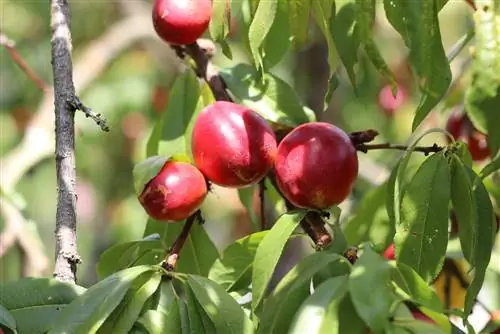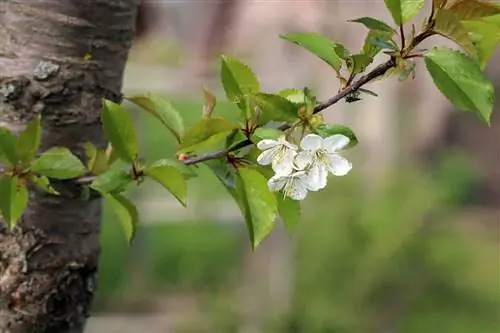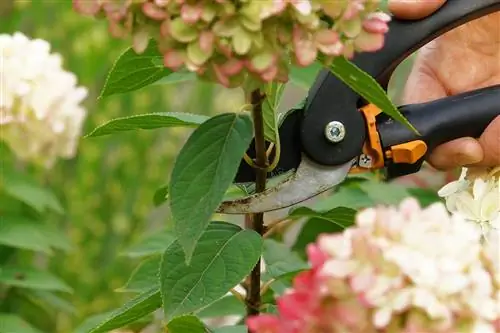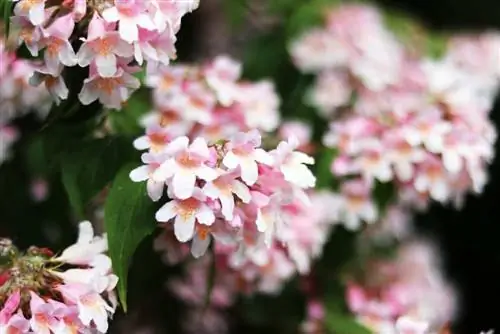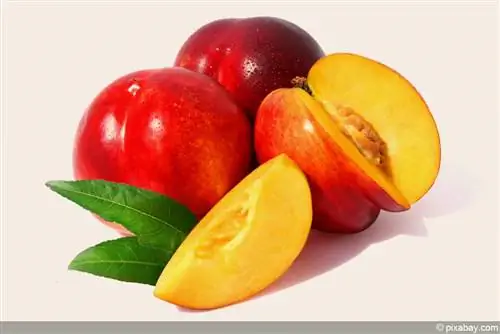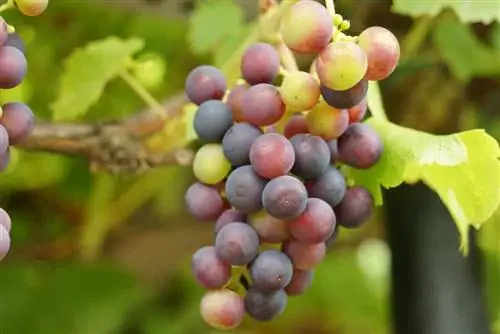- Author admin [email protected].
- Public 2023-12-17 03:39.
- Last modified 2025-01-24 12:45.
The nectarine is a mutation of a peach that has been further cultivated. The peach and the nectarine tree are similar in terms of care and pruning. The particular challenge when cutting nectarines is not so much the right time, but rather distinguishing whether a branch is bearing fruit or not. A close eye is required here, because non-supporting branches cost the tree unnecessary strength.
Pruning goals
Before pruning, it should be determined why the tree needs to be cut. This will also later decide how and what is cut. Reasons for pruning can be:
- Aging
- Promoting Growth
- Ventilation
- Increase in yield
- Improving fruit quality
Pruning is often underestimated, especially when it comes to the quality of the fruit. If the trees are not pruned regularly, fruit will form, but these are often tasteless and not sweet. It is therefore important not to be too timid when cutting, but also to specifically remove those branches that have no fruit potential.
Tool
Depending on the extent of pruning or tree care, the following tools are required:
- Garden scissors
- Pruning Shears
- Saw (hacksaw or pruning saw)
- Wire brush
Thinner branches can be removed with normal secateurs. If possible, bypass scissors should be used for this. Compared to anvil pruners, which transmit more force, they do not crush the branches. The same applies to pruning shears, which are used to cut thicker branches. The bypass variant should also be used here.
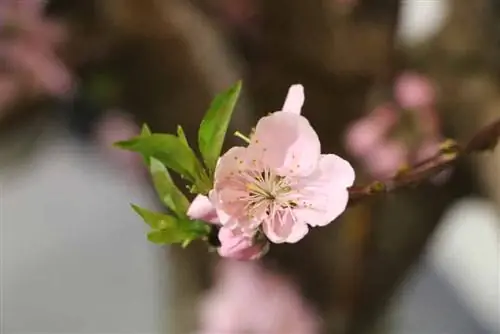
A saw is usually not necessary for regular pruning. It may only be necessary to remove thicker branches with a saw when making a rejuvenation cut. The wire brush itself is not needed for pruning, but should always be ready to hand when cutting. When pruning, the tree is always checked to see whether pests have laid eggs on it or whether a lot of moss or dense lichen has formed. These are then carefully removed with the wire brush as part of the pruning.
Tip:
Nectarines are very susceptible to various fungal infections. Therefore, clean the tool thoroughly before and after cutting to avoid infection and also minimize the risk of disease transmission to other trees.
Plant cutting
When pruning, which usually takes place in autumn with planting, there is no need to pay attention to any special features; it is usually the same for all trees. The plant pruning serves to promote strong and fruitful branches. The plant cut often also lays the foundation for the later shape of the crown. If you do everything right with this cut, you won't have to make any corrections to the crown later.
The plant cut serves primarily to promote vegetative development. Therefore, primarily a few strong and well-shaped branches are left standing. A maximum of four to five strong branches remain after planting. Compared to pruning other stone fruit trees, the pruning of a nectarine tree can be very heavy. The central shoot is usually shortened by half, while the other side branches are shortened to around a third.
Tip:
If the side branches themselves have already formed shoots, they are shortened to approx. 20 cm. This helps with wound healing and promotes the growth of he althy new long shoots.
When pruning, those shoots that have already formed many flower buds are also removed. They have the potential to produce their first fruits early on. However, this can have a detrimental effect on a young tree that does not yet have strong branches. It is usually unable to bear the load of several fruits, which can cause branches to break and make it difficult to form a beautiful crown.
Identifying fruit shoots
Before describing further cutting variants, it is important to recognize real and false fruit shoots. This is particularly relevant for care and rejuvenation cuts, because if incorrect fruit shoots are obtained, the nectarine will bear little to no fruit.
A close eye is necessary to distinguish between real and false escape instincts. False fruit shoots only have a maximum of two buds next to each other. This is usually a leaf and a flower bud. This makes it easy to distinguish them from so-called water shoots.

Water shooters are very thin shoots that have few buds and usually mainly single leaf buds. Real fruit shoots consist of three buds - one leaf and two flower buds. Such branches also have the potential to produce many fruits.
Tip:
Real fruit shoots are also shortened when pruning, which stimulates them to grow again.
care cut
Nectarines are vigorous trees, which is why annual pruning is essential. Annual pruning not only promotes development and fruit production, but also prevents the tree from aging over the years. The aim of pruning is to achieve uniform growth. This is also associated with an increase in yield. The editing process is done as follows:
- select shoots worth preserving
- Cut water shoots and false fruit shoots on 2 eyes
- shorten real fruit shoots by 1/3
- shorten other potential fruit shoots to 20 cm
The fruit shoots that are shortened to 20 cm are shoots whose whereabouts are still uncertain. As a rule, a decision is made after the harvest whether they should be retained or removed entirely.
When grooming, you should always pay attention to the shape of the crown. Nectarines are usually cultivated with a plate crown. This is a rather flat, but very wide crown. With a plate crown, it is particularly important to pay attention to a strong central shoot, which forms the leading branch, and stable side shoots. The side shoots must be able to support the weight of the fruit. Weak side shoots are therefore removed so that strong shoots can develop.
Rejuvenation cut
Rejuvenation pruning occurs when the tree has not been cared for for several years. This is often the case when an existing tree stand is taken over. Rejuvenation pruning is about stimulating growth and the formation of new, true fruit shoots. The rejuvenation cut is done as follows:
- select a leading branch (middle branch)
- remove old branches
- shape airy and translucent crown
- shorten aging side branches significantly
Particularly branches that have a lot of moss or lichen should be removed as a priority as part of the rejuvenation cut.
Cutting time
Nectarine pruning takes place during the growing season. The nectarine trees tolerate pruning very well, so pruning can be done both in spring and after the harvest in autumn. A little caution is only required when cutting in the frost-free winter. Cutting outside of the growing season encourages strong growth next spring. If this sprouting is not desired, the pruning should be postponed to another period.
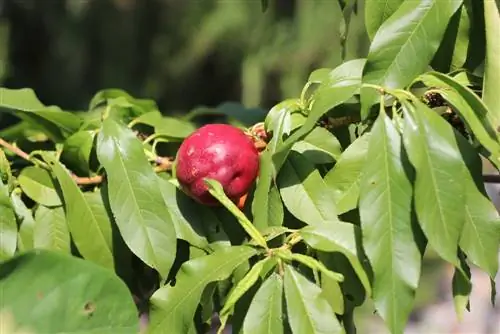
So that the buds on the nectarine tree are easier to recognize, pruning is usually done in late summer after the harvest. Additionally, further pruning can be done next spring when the trees bloom. Then you can see exactly which branches are real and false fruit shoots. This can be done again in the spring.
Nectarines are sensitive to late frosts, which often affect the flowers. If there is another frost late in spring that damages the flowers, they should also be removed by pruning. This means that no new buds will form that will bear fruit this year; fruit bud formation will take place in the fall, but it will promote he althy development and new growth from the nectarine tree.
Special cuts
The nectarine can not only be cut in the shape of a tree. Depending on the space available, there are also special cuts that get the maximum fruit out of it.
Trellis
Nectarines love it warm, which is why a trellis along a south-facing house wall is ideal. The culture of the espalier is a mixture of pruning and training. Central branches are trained and guided along the trellis, while side branches are regularly shortened. The aim is to maintain fruit formation on the side branches. Therefore, shoots along the side branches are shortened to a few eyes and the side branches are always shortened to the width of the trellis.
Column shape
Columnar fruit is particularly popular when space is limited, such as on terraces. Similar to espaliers, fruit production is concentrated on a few branches that grow steeply upwards. With columnar fruit, a maximum of 2 - 3 branches that grow steeply upwards remain. Side branches are shortened significantly because fruit formation primarily takes place on the central branches.
Spindle bush
Spindle bushes are mainly found in yield cultivation because the bushes are easy to care for and produce a high yield. If a nectarine is grown as a spindle bush, it usually requires a support structure, as they themselves are usually not able to support the weight of the branches. The side branches are fixed to the framework; anything that grows beyond the desired height is shortened. In addition, older branches of spindle bushes are removed every year so that the nectarine does not age.
Pruning for plant diseases

Nectarines, like their direct relatives, are often affected by a fungal disease called curl disease. The formation of fungal infections is particularly encouraged in densely packed branches because the leaves cannot dry quickly when it rains. In the event of a fungal infection, the first thing to check is whether the branches are too close together.
In this case, pruning can be done at any time, even during fruit formation. Often, nectarine trees affected by a fungal infection hardly produce any fruit and if they do, they are not as tasty as those from he althy trees. Therefore, it is irrelevant whether an infected branch is about to produce fruit or not. In addition, fruits would cost the tree a lot of energy in this phase, which is why it is an advantage to remove some of the supporting branches when cutting.
Tip:
A light crown not only protects the trees to a limited extent from fungal infection, but also makes pollination easier for insects and with more sun or space, tastier and larger fruits ripen.

